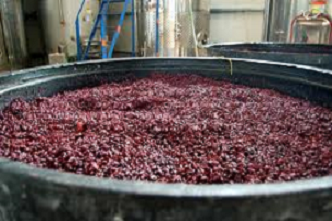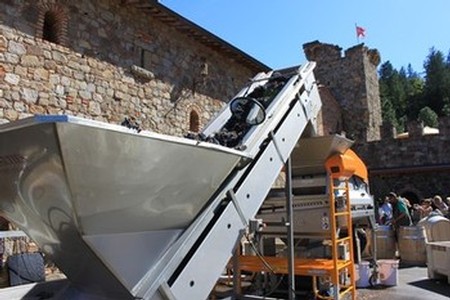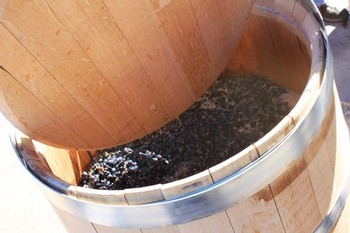Red Wine Barrel Fermentation

How to Ferment Wine: Our Red Wine Oak Barrel Fermentation Process
During the Harvest season, there are always exciting things going on around the Castello, and today on the Crush Pad was no exception. Today, for the first time at the Castello, our winemaking team reserved a small lot of our Don Thomas Vineyard Cabernet Sauvignon for fermentation directly in French Oak Barrels.
Traditionally, the fermentation process takes place in stainless steel tanks, where the must (skins and seeds of the grapes) are cold-soaked with the juice before yeast is added. The cap, or layer of skins and seeds that get pushed to the top of the tanks from the activity taking place during fermentation, is broken up by either the punch-down or pump-over method, both of which ensure an even distribution of the color and flavors we wish to impart into our red wines. After five to eight days in these fermentation tanks, the juice is pressed from the skins and seeds and pumped into French Oak barrels for aging in the Castello’s extensive underground cave and cellar system.
What is barrel fermentation? Barrel fermentation means that the freshly destemmed grapes and their juices are pumped directly into French Oak barrels whose heads have been removed. Dry ice is added to cool the berries before the barrel heads are secured to seal in the must. The barrels are then laid on a rack that allows them to be rolled back and forth daily to ensure the cap stays moist and the oak is evenly introduced to the fermenting must and juice. Typically, two full barrels of must and juice will amount to one barrel of wine. The process of fermenting the juice in oak barrels helps to impart an added silkiness to the tannins and a rounder, more lush mouthfeel, especially to Bordeaux varietals. This extremely labor-intensive method of fermentation is typically reserved for only the most exclusive of wines, and the highly-acclaimed Cabernet Sauvignon from the Don Thomas Vineyard is an exceptional example of the quality of grapes deserving of such treatment.
The Don Thomas Cabernet Sauvinon clusters are conveyed into the berry sorter/ destemmer as a lucky tour group watches
The new French Oak barrels are filled directly from the destemmer
Our Cellar Supervisor, Chema, overseeing the juice and must being pumped into a special French Oak barrel that has a door in place to make filling and emptying easier
The deconstructed barrel waiting to be resealed with the juice and must inside
Dry ice is added to the must before the barrels are resealed to help cool off the berries
Resealing the barrel heads before they are sent into the cellars to begin the fermentation process
The barrels are stored in a special temperature-controlled room in the Castello’s cellars during the fermentation process.
Bring on the Pig-ment-Skin

Mary Davidek
Bring on the Pig-ment-Skin
As summer comes to a close and long hot days become abbreviated and alleviated with cooler temps and sweater worthy evenings–September is here. With it, the beauty of harvest and fall is underway. Undeniably my favorite time of the year; the anticipation, the realization of another season. Nervously…… we wait. The hopes, the expectations— will it be as good as last year? Will this year bring the success of another triumph? Will we get the points and revel in great scores? It has finally arrived.
That’s right… are you ready for some football!?
Regular season NFL starts this week and the pigskin is finally back in action. Of course, while the football is being passed and punted on the gridiron the red zone has officially been crossed at my house. Bring on the pigment!
All wine grapes contain clear juice. Although there are a few varietals with tinted juice it is extremely rare. Red wine becomes colored or pigmented in the winemaking process. The liberated or pressed juice of black grapes are fermented in contact with the skins. Since the skins contain all the color, fermentation with the skins extracts this color to the juice and resultant wine. The skin of black grapes also contains complex elements that not only result in this pigmented juice, but imparts tannins and many healthful antioxidants.
My match-up this week includes Cabernet Sauvignon; and since it doesn’t get much more pigmented than this thick-skinned varietal… well….. this pairing calls for a pepper spiked little pig of my own to mark the occasion.
Cheers, or as they say on the field—get ready for kickoff!

No need for binoculars! View this action live and in person from the proverbial 50 yard line! Fall is the time of year for a trip to wine country. Watch the winemaking process from Castello di Amorosa’s home field, the crush pad!

Talk about score! Robert Parker gave Castello di Amorosa’s 2009 Cabernet Sauvignon 91 points! This 100% Cabernet Sauvignon is brawny with loads of muscle yet exhibits a graceful and elegant mouth feel. Brooding deep dark fruit with a hint of spice box and black pepper. Touchdown!

Simple, quick and delicious. This meal won’t keep you away from important plays! I sprinkled the tenderloin with sea salt and garlic powder then very generously coated it with coarse ground pepper. Bake at 350 degrees until the center of the loin reaches 150 deg. Let rest for 10-15 minutes before serving. The peppery seasoned tenderloin plays off the dark fruit of the Cabernet. After Sunday’s match-up this makes for incredible sandwiches to enjoy the next night…during Monday Night Football!










